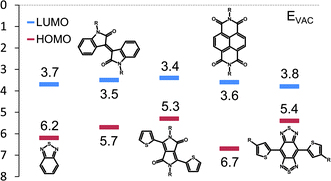In their Energy and Environmental Science Perspective article, Jonathan D. Yuen and Fred Wudl review the advances in high performance, or rather high mobility, donor–acceptor polymers. The first comment is on the fact that the field apparently has been focusing on the donor part of the assembly, making it a case of DONOR–acceptor polymers. To make amends Wudl and Yuen focused on the acceptor part, returning the focus to the entire DONOR–ACCEPTOR polymer.
The grand achievement in the field of donor–acceptor polymers is that mobilities surpassing 1 cm2/Vs now are routinely reported. Indeed the 10 cm2/Vs boundary is being threatened. This impressive accomplishment is a result of innovation in chemical structure, focusing on both the donor and acceptor units; as well as a continued effort to understand and optimize the structure of the donor–acceptor polymers on device platforms.
The work outlined in this perspective is technical and complicated. The results of a major commercial breakthrough are not. Carbon-based photovoltaics — solar cells — will allow for sustainable energy production. The next challenge will be to manufacture the donor-acceptor polymers exclusively from renewable sources.
by Dr Thomas Just Sørensen
Read this exciting EES Perspective today:
Strong acceptors in donor–acceptor polymers for high performance thin film transistors
Jonathan D. Yuen and Fred Wudl
DOI: 10.1039/C2EE23505F











